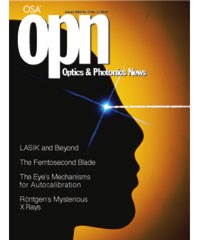
January 2002 Issue
Feature Articles
The Femtosecond Blade: Applications in Corneal Surgery
Surgeons use a number of devices to create incisions in tissue. These include steel and gem blades, radio frequency, high-pressure waterjet, and electrocautery technologies. Interestingly, while lasers have an established place in the operating room, as cutting tools they play a minor role. Until recently, a major limiting factor was the lack of three-dimensional precision found with each of three types of laser-tissue interaction: photocoagulation, photoablation, and photodisruption.
by Tibor Juhasz, Ron Kurtz, Christopher Horvath, Carlos Suarez, Ferenc Raksi, and Greg SpoonerLasik and Beyond
Laser-assisted in situ keratomileusis, better known as LASIK, is a surgical procedure for reducing refractive error in the eye. In this procedure, a device called a microkeratome is used to shave a thin, hinged flap in the cornea. The flap is folded back to expose the internal tissue of the cornea. Pulses from an excimer laser operating at a wavelength of 193 nm are then delivered to this tissue to modify its shape. This wavelength is used because it ablates tissue without extensive collateral damage and because it has low mutagenicity.
by Jim SchwiegerlingThe Eye's Mechanisms for Autocalibration
As those of us who build optical instruments are all too aware, changes in the environment surrounding an instrument or changes within the instrument itself can quickly throw it out of calibration. This usually requires someone to intervene and restore the device to its calibrated state. The human visual system, on the other hand, does not enjoy the luxury of such a caretaker, and must calibrate itself continuously. Evolution has created ingenious mechanisms that maintain optimal visual performance over the three-quarters of a century that corresponds to a typical human lifespan.
by Heidi Hofer and David R.WilliamsMaking the Invisible Visible: Röntgen's Mysterious X Rays
Amateur scientists who traveled from town to town in the mid-nineteenth century delighted audiences by showing them the ancestor of the neon sign: the air was pumped out of a glass tube with platinum wires embedded in opposite ends, and the interior was made to glow in lively patterns when a high voltage was run across the wires. Transfixed by the fluorescence, the lecturers had however absolutely no idea what caused the electrical excitation in the vacuum tube.
by Brian S. BaigrieDepartments and Columns
Federal Funding Choices in the Anthrax Era
Given an expected federal budget deficit in fiscal 2002, there won’t be enough money to fully meet every public health need. Choices will have to be made. The importance of making the right funding choices is underlined by past failures to do much of anything to establish an infrastructure to detect and respond to a chemical or biological attack.
In Canada, Rural Fiber Network Sets the Pace
Retired policemen operate one of the newest high-speed communication networks in Canada. But you won’t find any of its hubs in the country’s urban centers.
Venture Capital in Optics: Barren Desert...or Secluded Oasis?
Optical communications, like most ofthe rest of the communications industry, is struggling mightily in today’s business environment. This situation, which has cast a pall over the entire industry, has given rise among venture capitalists to a generally skeptical bias toward optics startups.
Teaching the Physics of a Diode-Pumped Laser
To teach the basic physics of laser radiation, with support from the government of Argentina we designed a modular kit featuring all the solid-state components necessary to assemble a Nd:YAG laser.
The Uncertainty Principle in Classical Optics
In this article we address two problems that have widespread applications in optical metrology, spectroscopy, telecommunications, etc., and discuss the constraints imposed by the uncertainty principle on these problems.
Uncle Sam and Auntie Trust
In this month’s column we examine the basics of antitrust law: its origins, the main bodies of law, and how antitrust issues arise.
Bioterrorism and Social Choice: Public Health vs. Health Care
Although the nation’s defense and intelligence community had not been successful in preventing the September 11 hijackings, the military and defense apparatus was able to mount a credible response. The country’s public health system, in contrast, appeared unequal to the task of responding to the bioterrorist threat.
ADVERTISEMENT
ADVERTISEMENT
Also in this Issue
Book Reviews
Bose-Einstein Condensates and Atom Lasers Handbook of Medical Imaging, Volume 2: Medical Image Processing and Analysis Infrared and Raman Spectroscopy of Biological Materials Mechanical Properties of Ceramics Electromagnetic Resonances in Nonlinear Optics

![Infinity Mirrored Room– Brilliance of the Souls 2014 by artist Yayoi Kusama. [© YAYOI KUSAMA]](https://opnmedia.blob.core.windows.net/$web/opn/media/images/articles/2024/0724/departments/202407-cover-web.jpg?ext=.jpg)
![An experimental scheme demonstrated by researchers at Princeton and Yale universities, USA, can convert physical noise into errors that can be corrected more easily. [F. Wojciechowski, Princeton University]](https://opnmedia.blob.core.windows.net/$web/opn/media/images/articles/2024/0624/departments/202406-cover-web.jpg?ext=.jpg)
